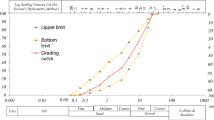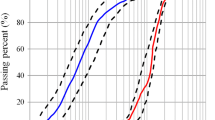Abstract
Moisture and aggressive ions transferring into concrete have detrimental effects on durability of reinforced concrete structure. To tackle this problem, damp-proofing admixtures, like calcium stearate, can be incorporated in the mixture design of concrete to restrict water and aggressive ions’ ingress into concrete. Calcium stearate is a damp-proofing admixture which can provide a water-repellent layer along the capillary pores. As a result, it can reduce permeability of concrete under non-hydrostatic condition. This study investigates the effects of calcium stearate on properties of fresh and hardened concretes. To this end, 12 mixtures with different water-to-cementitious materials (w/cm) ratios but constant ratio of cement paste-to-aggregate were prepared and moist-cured for 180 days. The major outcomes of fresh concrete analysis showed that high dosage of calcium stearate in low w/cm ratios increased the air content and reduced the density of fresh concrete. It also decreased the workability of fresh concrete, regardless of the w/cm ratio and the dosage of calcium stearate. The findings of compressive strength analysis indicated that calcium stearate reduced compressive strength, even when low dosage of calcium stearate was added to the concrete mixture. Based on permeability test results, calcium stearate could improve permeability under non-hydrostatic pressure. However, incorporation of calcium stearate was not found to be an effective approach to decrease permeability under hydrostatic pressure. Finally, microstructure analysis showed that CS has adverse effect on the interfacial transient zone.











Similar content being viewed by others
References
ACI 212.3R-10. (2017). Report on Chemical Admixtures for Concrete, Chapter 15: Permeability reducing admixtures. Reported by ACI committee 212.
Ahmadi, B., & Shekarchi, M. (2010). Cement & Concrete Composites Use of natural zeolite a supplementary cementitious material. Journal of Cement and Concrete Composite., 32(2), 134–141.
ASTM C1723-16. Standard Guide for Examination of Hardened Concrete Using Scanning Electron Microscopy.
ASTM C231/C2131 M-17a. Standard Test Method for Air Content of Freshly Mixed Concrete by Pressure Method.
BS-EN 12350-6 (2009). Testing fresh concrete- Part6: Density.
BS-EN 12390-3 (2009). Testing hardened concrete- Part3: Compressive strength of test specimens.
BS-EN 12390-8 (2009). Testing Hardened Concrete. Depth of Penetration of Water Under Pressure.
BS-EN 1881-122 (2011). Testing concrete- Part 122: Method for determination of water absorption.
Corinaldesi, V. (2012). Combined effect of expansive, shrinkage reducing and hydrophobic admixtures for durable self compacting concrete. Journal of Construction and Building Materials., 36, 758–764.
Falchi, L., Müller, P., Fontana, F., Izzo, C., & Zendri, E. (2013). Influence and effectiveness of water-repellent admixtures on pozzolana-lime mortars for restoration application. Journal of Construction and Building Materials., 49, 272–280.
Falchi, L., Zendri, E., Müller, U., & Fontana, P. (2015). The influence of water-repellent admixtures on the behaviour and the effectiveness of Portland limestone cement mortars. Journal of Cement and Concrete Composite, 59, 107–118.
Hajforoush, M., Madandoust, R., & Kazemi, M. (2019). Effect of simulataneous utilization of natural zeolite and magnetic water on engineering properties of self-compacting concrete. Asian Journal of Civil Engineering., 20, 289–300.
Izaguirre, A., Lanas, J., & Alvarez, J. (2011). Effect of water-repellent admixtures on the behaviour of aerial lime-based mortars. Journal of Construction and Building Materials., 25(2), 992–1000.
Lagazzo, A., Vicini, S., Cattaneo, C., & Botter, R. (2016). Effect of fatty acid soap on microstructure of lime-cement mortar. Journal of Construction and Building Materials., 116, 384–390.
Lanzón, M., & García-Ruiz, P. A. (2008). Effectiveness and durability evaluation of rendering mortars made with metallic soaps and powdered silicone. Journal of Construction and Building Materials., 22(12), 2308–2315.
Lanzón, M., & García-Ruiz, P. A. (2009). Evaluation of capillary water absorption in rendering mortars made with powdered waterproofing additives. Journal of Construction and Building Materials., 23(10), 3287–3291.
Lanzón, M., Martínez, E., Mestre, M., & Madrid, J. A. (2017). Use of zinc stearate to produce highly-hydrophobic adobe materials with extended durability to water and acid-rain. Journal of Construction and Building Materials., 139, 114–122.
Ma, C., & Chen, B. (2016). Properties of foamed concrete containing water repellents. Journal of Construction and Building Materials., 123, 106–114.
Maryoto, A. (2015). Improving microstructures of concrete using Ca(C18H35O2)2. Journal of Procedia Engineering, 125, 631–637.
Maryoto, A. (2017). “Resistance of concrete with calcium stearate due to chloride attack tested by accelerated corrosion. Journal of Procedia Engineering., 171, 511–516.
Nemati Chari, M., Shekarchi, M., Ghods, P., & Moradian, M. (2016a). A simple practical method for determination of moisture transfer coefficient of mature concrete using a combined experimental-numerical approach. Journal of Computers and Concrete., 18(3), 367–388.
Nemati Chari, M., Shekarchi, M., Sobhani, J., & Nemati Chari, M. (2016b). The effect of temperature on the moisture transfer coefficient of cement-based mortars: An experimental investigation. Journal of Construction and Building Materials., 102, 306–317.
Nemati Chari, M., Shekarchi, M., Tadayon, H., & Moradian, M. (2018). Prediction of chloride ingress into blended cement concrete: Evaluation of a combined short-term laboratory-numerical procedure. Journal of Construction and Building Materials., 162, 649–662.
Sabet, F., Libre, N., & Shekarchi, M. (2013). Mechanical and durability properties of self consolidating high performance concrete incorporating natural zeolite, silica fume and fly ash. Journal of Construction and Building Materials, 44, 175–184.
Saleh Ahari, R., Erdem, T. K., & Ramyar, K. (2015). Permeability properties of self-consolidating concrete containing various supplementary cementitious materials. Journal of Construction and Building Materials., 79, 326–336.
Tittarelli, F. (2009). Oxygen diffusion through hydrophobic cement-based materials. Journal of Cement and Conrete Research., 39(10), 924–928.
Tittarelli, F., Carsana, M., & Ruello, M. L. (2014). Effect of hydrophobic admixture and recycled aggregate on physical-mechanical properties and durability aspects of no-fines concrete. Journal of Construction and Building Materials., 66, 30–37.
Tittarelli, F., & Moriconi, G. (2010). The effect of silane-based hydrophobic admixture on corrosion of galvanized reinforcing steel in concrete. Journal of Cement and Conrete Research., 52(9), 2958–2963.
Tittarelli, F., & Moriconi, G. (2011). Comparison between surface and bulk hydrophobic treatment against corrosion of galvanized reinforcing steel in concrete. Journal of Cement and Conrete Research., 41(6), 609–614.
Vejmelková, E., Koňáková, E., Čáchová, M., Keppert, M., & Černý, R. (2012). Effect of hydrophobization on the properties of lime-metakaolin plasters. Journal of Construction and Building Materials., 37, 556–561.
Vishvanath, N., Kanthe, Shirish V., & Deo, Meena Murmu. (2018). Effect of fly ash and rice husk ash on strenght and durability of binary and ternary blend cement mortar. Asian Journal of Civil Engineering., 19, 963–970.
Wong, H. S., Barakat, R., Alhilali, A., Saleh, M., & Cheeseman, C. R. (2015). Hydrophobic concrete using waste paper sludge ash. Journal of Cement and Concrete Research, 70, 9–20.
AASHTO T358-17. Standard Method of Test for Surface Resistivity indicating Concrete’s Ability to Resist Chloride Ion Penetration. Standard by American Association of State and Highway Transport Officials.
ASTM C143/C143 M-15a. Standard Test Method for Slump of Hydraulic-Cement Concrete.
ASTM C33/C33 M-16. Standard Specification for Concrete Aggregates. American Society for Testing and Materials.
Zhu, Y. G., Kou, S. C., Poon, C. S., Dai, J. G., & Li, Q. Y. (2013). Influence of silane-based water repellent on the durability properties of recycled aggregate concrete. Journal of Cement and Concrete Composite., 35(1), 32–38.
Acknowledgements
Current research study was fully supported by concrete technology department of Road, Housing & Urban Development Research Centre in Tehran, and the authors are immensely grateful of the staff of this department for their collaboration in this experimental research.
Author information
Authors and Affiliations
Corresponding author
Ethics declarations
Conflict of interest
The authors declare that they have no conflict of interest
Additional information
Publisher's Note
Springer Nature remains neutral with regard to jurisdictional claims in published maps and institutional affiliations.
Rights and permissions
About this article
Cite this article
Nemati Chari, M., Naseroleslami, R. & Shekarchi, M. The impact of calcium stearate on characteristics of concrete. Asian J Civ Eng 20, 1007–1020 (2019). https://doi.org/10.1007/s42107-019-00161-x
Received:
Accepted:
Published:
Issue Date:
DOI: https://doi.org/10.1007/s42107-019-00161-x




